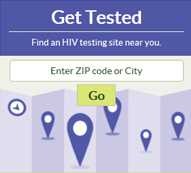CDC HIV/AIDS Update: National HIV Testing Day
June 26, 2015
Dear Colleagues,
Tomorrow we observe National HIV Testing Day, which reinforces and promotes the importance of HIV testing to increase the number of people who are aware of their HIV status.
In the United States nearly 1 in 8 people living with HIV don’t know they have it; that is 12.8% of the 1.2 million people who are living with HIV. A recent Centers for Disease Control and Prevention (CDC) analysis showed that 30% of new HIV infections were transmitted from people who did not know that they were infected. People who have been diagnosed and are in care are less likely to transmit HIV, in part because they are more likely to protect their partners from infection.
Since the HIV test was first introduced more than 30 years ago, we’ve seen tremendous advances in HIV prevention. Laboratory tests can now detect HIV infection as soon as a few days after exposure, allowing for earlier diagnosis and improved opportunities to connect people to life-extending treatment. Because of the benefits of early treatment, CDC recommends that individuals between the ages of 13 and 64 get tested for HIV at least once as part of routine health care, and those at increased risk—people with multiple sex partners, people with sexually transmitted diseases, and people who inject drugs—get tested at least once a year. Sexually active gay and bisexual men may benefit from even more frequent testing, depending on their risk.
CDC is working hard to ensure HIV testing is increased across the country, and health departments and community-based organizations have resources to help ensure those diagnosed with HIV are linked to prompt, ongoing medical care and treatment. In 2013 there were more than 3.3 million CDC-funded HIV testing events in the United States. Testing in both health care (e.g. STD clinics, emergency departments, primary care clinics) and non-health care settings (e.g., HIV counseling & testing site, bar/club, other community settings) are effective in reaching undiagnosed persons. According to this week’s Morbidity and Mortality Weekly Report (MMWR), among health care settings, primary care and sexually transmitted disease (STD) clinics accounted for more HIV tests than did other sites, and STD clinics identified more new positives. In non–health care settings, HIV counseling and testing sites accounted for the most tests and identified the highest number of new positives.
A second MMWR analysis shows that by the end of 2012, five jurisdictions met the National HIV/AIDS Strategy (NHAS) objective to increase the percentage of people living with HIV who know their status to 90%. By focusing HIV testing efforts toward the most efficient health care settings and community venues, we can help identify persons newly diagnosed with HIV, link more people to HIV care, and ultimately achieve the NHAS goals. CDC continually supports partnerships to make HIV testing and screening accessible and routine by
- Providing over $339 million in funding to health departments to develop and implement comprehensive HIV prevention programs that include: expansion of HIV testing for disproportionality affected populations, implementation of CDC’s routine testing recommendations, and enhancement of health departments’ capacities to refer and link HIV positive persons to medical care.
- Awarding $55 million over 5 years to 34 community-based organizations to provide HIV testing to young gay and bisexual men of color, transgender youth of color, and their partners.
- Implementing the MSM (men who have sex with men) Testing Initiative, which seeks to identify at least 3,000 MSM who were previously unaware of their infection, link at least 85% of those diagnosed with HIV into medical care, and determine which strategies are best for identifying undiagnosed HIV-infected MSM.
- Piloting HIV testing programs in urban and rural pharmacies.
- Delivering Act Against AIDS communication campaigns designed to increase HIV testing, awareness, and education, such as Let’s Stop HIV Together, Reasons/Razones, Take Charge. Take the Test., HIV Screening. Standard Care., and Testing Makes Us Stronger.
On National HIV Testing Day there are hundreds of HIV testing events occurring nationwide—in health care settings and a variety of community venues—that provide free or low-cost confidential testing to everyone. Today and throughout the year, these and other efforts will help prevent new infections and ensure that people living with HIV take care of their health.
Thank you for your commitment to HIV prevention. We are confident that with your continued support we will realize a future free of HIV and AIDS.
Sincerely,
/Jonathan Mermin/
Jonathan H. Mermin, M.D., MPH
Director
National Center for HIV/AIDS, Viral Hepatitis, STD, and TB Prevention
Centers for Disease Control and Prevention
www.cdc.gov/nchhstp
/Eugene McCray/
Eugene McCray, MD
Director
Division of HIV/AIDS Prevention
National Center for HIV/AIDS, Viral Hepatitis, STD, and TB Prevention
Centers for Disease Control and Prevention
www.cdc.gov/hiv
- Page last reviewed: January 25, 2016
- Page last updated: January 25, 2016
- Content source:


 ShareCompartir
ShareCompartir


